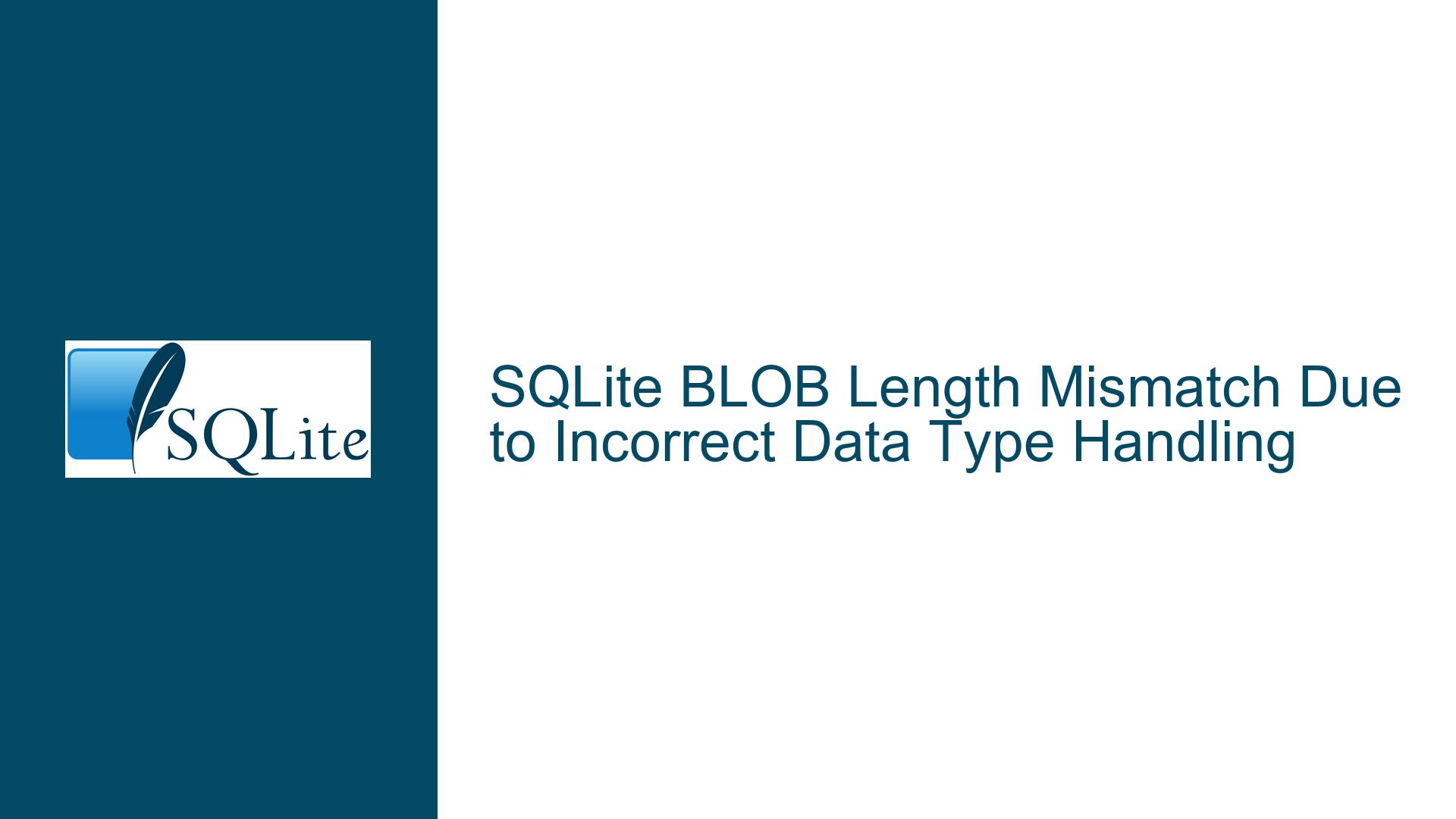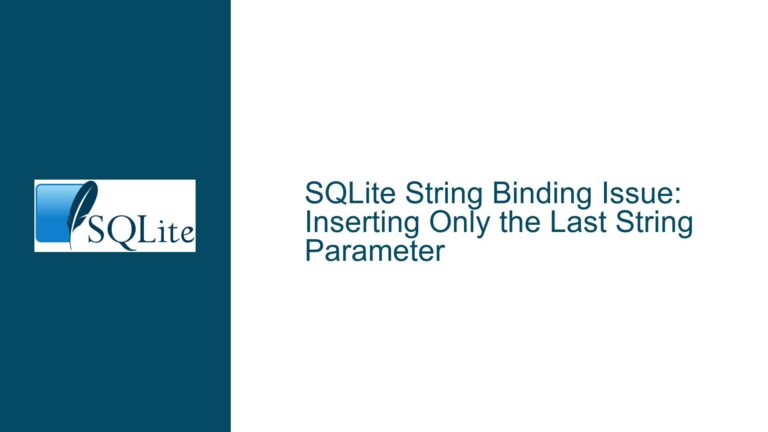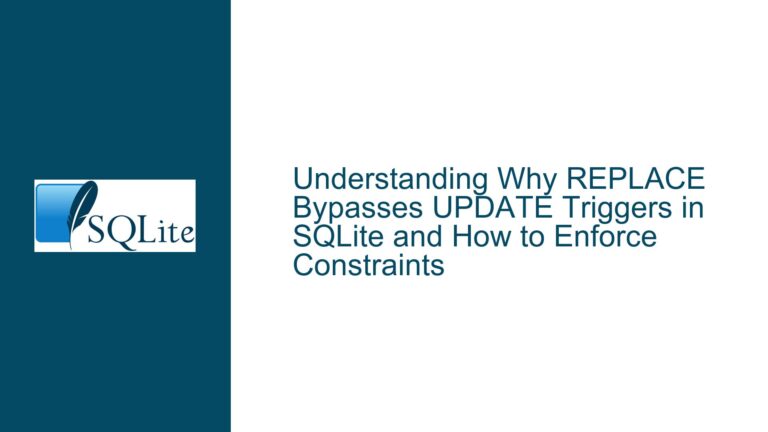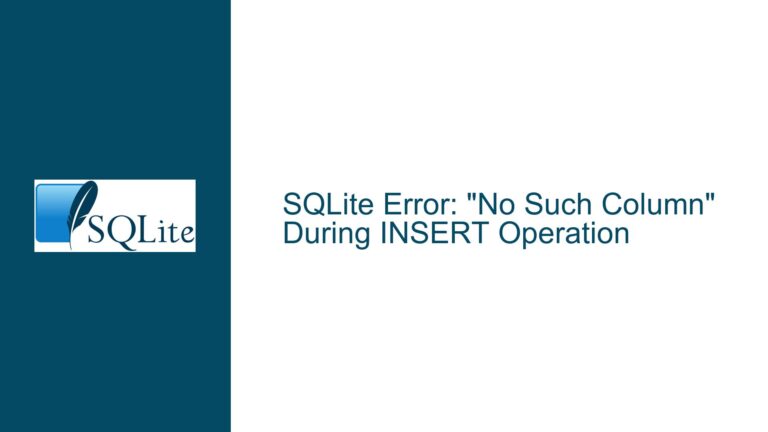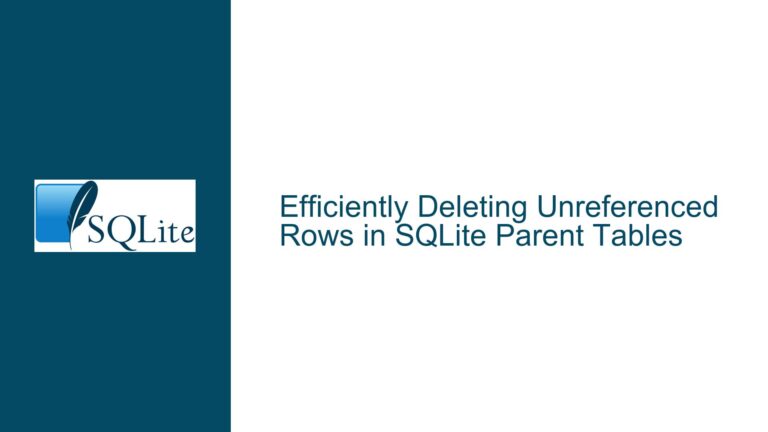SQLite BLOB Length Mismatch Due to Incorrect Data Type Handling
BLOB Length Calculation Yields Characters Instead of Bytes
The core issue revolves around the behavior of the length() function in SQLite when applied to BLOB (Binary Large Object) data. According to the SQLite documentation, the length(X) function should return the number of bytes in a BLOB value X. However, in practice, when a BLOB contains valid UTF-8 sequences, the length() function returns the number of characters instead of bytes. This discrepancy occurs even if the BLOB contains mostly invalid UTF-8 sequences, as only the valid sequences are converted to characters before the length is calculated.
This behavior is problematic because BLOBs are intended to store arbitrary binary data, not text. The expectation is that the length() function should treat BLOBs as raw byte sequences, regardless of their content. The issue is further complicated by the fact that SQLite’s type system is dynamic, meaning that the actual type of a value in a column can differ from the column’s declared type. This dynamic typing can lead to unexpected results when performing operations like length() on BLOB data.
Misinterpretation of BLOB Data as TEXT During Insert/Update Operations
The root cause of the issue lies in how data is inserted or updated in the SQLite database. Even though a column is declared as a BLOB, the data being inserted or updated may be interpreted as TEXT if the underlying ODBC driver or application code does not explicitly handle the data as binary. This misinterpretation occurs because SQLite’s type affinity system allows for flexible type handling, and the actual type of a value is determined at runtime based on the data provided.
For example, if an ODBC driver or application code sends data to SQLite without explicitly marking it as binary, SQLite may interpret the data as TEXT, especially if the data contains valid UTF-8 sequences. This misinterpretation can lead to the length() function returning the number of characters instead of bytes, as the data is treated as TEXT rather than BLOB.
The issue is further exacerbated by the fact that SQLite’s type system does not enforce strict type checking. This means that even if a column is declared as a BLOB, the actual values stored in the column can be of any type, including TEXT. This flexibility can lead to confusion and unexpected behavior, especially when dealing with binary data that may contain valid UTF-8 sequences.
Ensuring Correct BLOB Handling in SQLite with ODBC and Type Checking
To resolve the issue, it is essential to ensure that binary data is correctly handled as BLOB during insert and update operations. This can be achieved by explicitly marking the data as binary when using ODBC or other database access methods. Additionally, using SQLite’s typeof() function can help verify the actual type of the data stored in a column, ensuring that it is indeed a BLOB.
Step 1: Verify Data Type with typeof()
Before performing any operations on a column that is expected to contain BLOB data, use the typeof() function to verify the actual type of the data. This step is crucial because it helps identify whether the data is being misinterpreted as TEXT.
SELECT typeof(column_name), column_name FROM table_name;
If the typeof(column_name) returns ‘text’ instead of ‘blob’, it indicates that the data is being interpreted as TEXT, and corrective measures are needed.
Step 2: Explicitly Mark Data as Binary in ODBC
When using ODBC to insert or update BLOB data, ensure that the data is explicitly marked as binary. This can be done by using the appropriate ODBC data types, such as SQL_BINARY or SQL_LONGVARBINARY, depending on the ODBC driver and the size of the data.
For example, in Python using the pyodbc library, you can use the pyodbc.Binary type to ensure that the data is treated as binary:
import pyodbc
data = b'\x01\x02\x03\x04' # Example binary data
conn = pyodbc.connect('DSN=your_dsn')
cursor = conn.cursor()
cursor.execute("INSERT INTO table_name (blob_column) VALUES (?)", pyodbc.Binary(data))
conn.commit()
Step 3: Use SQLite’s CAST Function to Enforce BLOB Type
If you need to ensure that a value is treated as a BLOB within SQLite, you can use the CAST function to explicitly cast the value to a BLOB. This can be useful when dealing with data that may be misinterpreted as TEXT.
INSERT INTO table_name (blob_column) VALUES (CAST(? AS BLOB));
Step 4: Implement CHECK Constraints to Enforce BLOB Type
To prevent TEXT data from being stored in a BLOB column, you can implement a CHECK constraint that enforces the BLOB type. This constraint ensures that only BLOB data can be inserted or updated in the column.
CREATE TABLE table_name (
blob_column BLOB NOT NULL CHECK (typeof(blob_column) = 'blob')
);
Step 5: Review and Update Application Code
Review the application code that interacts with the SQLite database to ensure that binary data is correctly handled as BLOB. This includes checking the data types used in database access libraries and ensuring that binary data is not inadvertently converted to TEXT.
Step 6: Test with SQLite CLI
To verify that the data is being correctly handled as BLOB, use the SQLite command-line interface (CLI) to create a test database and insert BLOB data. This step helps confirm that the data is being stored and retrieved as expected.
CREATE TABLE test_table (blob_column BLOB);
INSERT INTO test_table VALUES (x'0123456789');
SELECT typeof(blob_column), blob_column FROM test_table;
The output should indicate that the blob_column contains BLOB data, and the length() function should return the number of bytes.
Step 7: Monitor and Audit Data Types
Regularly monitor and audit the data types stored in your SQLite database to ensure that they match the expected types. This can be done using the typeof() function and by reviewing the application code and database access methods.
Step 8: Update Documentation and Training
Ensure that your team is aware of the nuances of SQLite’s type system and the importance of correctly handling binary data. Update documentation and provide training to prevent similar issues in the future.
Step 9: Consider Database Migrations
If you discover that existing data in your database is being misinterpreted as TEXT, consider performing a database migration to correct the data types. This may involve exporting the data, ensuring that it is correctly typed, and then re-importing it into the database.
Step 10: Use SQLite’s PRAGMA Statements
SQLite provides several PRAGMA statements that can help manage and diagnose issues related to data types and storage. For example, PRAGMA encoding can be used to check the database encoding, which may affect how data is stored and interpreted.
PRAGMA encoding;
This command returns the encoding used by the database, which can help identify potential issues with text encoding and BLOB handling.
Conclusion
The issue of the length() function returning characters instead of bytes for BLOB data in SQLite is primarily caused by the misinterpretation of binary data as TEXT during insert and update operations. By explicitly marking data as binary, using SQLite’s typeof() function to verify data types, and implementing CHECK constraints, you can ensure that BLOB data is correctly handled in your SQLite database. Regular monitoring and auditing of data types, along with proper documentation and training, will help prevent similar issues in the future.
